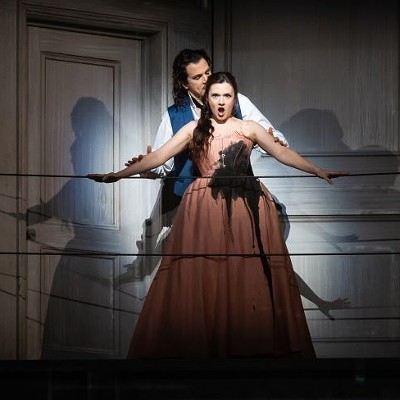The 2009 comedy Untitled is an affectionate send up of New York City's pretentious and fashionably hermetic conceptual art and "new music" scenes. Its two main characters, a beautiful, black rubber-clad gallery owner and a scowling, piano abusing composer, share a passion for art and music, and mutual disgust for any creative effort that smacks of commercialism. There are many humorously scripted and shot encounters between the artists and musicians throughout the film. In one scene, one of the supporting characters (a visual artist whose work adorns five-star hotel lobbies) encounters a conceptual artist's work entitled: Wall surrounding space (2007), which is...well, just that. A white wall in an art gallery albeit with a title and a date.
Most of the composer's chamber music performances in Untitled consist of fortissimo piano clusters, relentless bass clarinet shrieks, and arrhythmic percussion hits interspersed with sobs, well placed kicks to a metal bucket, and an on-cue tearing in half of the magazine All About Jazz (Nice touch!). Everything except silence and space are utilized to create the mindlessly aggressive music and the results are not only hilarious, but unfortunately probably reflect what most people imagine contemporary classical music to sound like.
But silence or just lack of audible "musical" activity can freak out an audience as well. Composer, writer, and painter John Cage, described on Art Attack as "one of those insane cats you can't help but love" (?), proposed that silence itself is not only worth listening to, but could be part of the concert hall's repertoire. Cage's infamous 4'33" (four minutes and thirty three seconds of just silence) and the conceptual works of composers La Monte Young and Yoko Ono surely inspired the "works" of the conceptual artist portrayed in Untitled, including the aforementioned Wall surrounding space. At one point, the artist states without a trace of irony: "I want my work to have the whole world in it. And I want it to mean everything to everyone. But I don't want to add to it."
Just because something's funny, it doesn't mean it's not important. In his book The Advancing Guitarist: Applying Guitar Concepts & Techniques, Jazz guitarist Mick Goodrick helpfully provides the reader a few examples of effective use of silence in music:
1.)
2.)
3.)
When trumpeter Miles Davis asked tenor and soprano saxophonist John Coltrane to cut down how long he soloed in performance, Coltrane told him that when he started soloing, he just didn't know how to stop. Miles said, "Try taking the horn out of your mouth."
In music performance, "space" can refer to the empty space that one instrument leaves for another instrument to inhabit. "Silence" might be defined as those moments when you take the horn out of your mouth. Space and silence are crucial components to all music, no matter what the genre or idiom. There are no rules as to when to be silent or for how long, but when used effectively, the resulting music can be sublime.
If we say "I love the silences!" after hearing a piece of music, are we inadvertently insulting the musicians? Listen to Bill Evans and Jim Hall's version of Darn That Dream before answering:
Somewhere in between Untitled's chamber music from hell and "wall surrounding space" exists the conversational interplay between musical sounds and the musicians that produce them. Of course, the sound of a family yelling over each other at the dinner table is a valid (though exhausting) way to carry on a conversation. But music, if you could sit it down and talk with it, would tell you that it isn't interested in just one mode of expression. Open space that leaves room for some back and forth between musicians is an experience most ears welcome. You've heard the expression, "It's like talking to a wall?" Where's the fun in that?
Seriously, now. Here are a couple more examples of effective use of silence and space. Please feel free to share with us some of your own.
John Lee Hooker Boom, Boom, Boom
Fred Frith and Otomo Yoshihide improvisation





